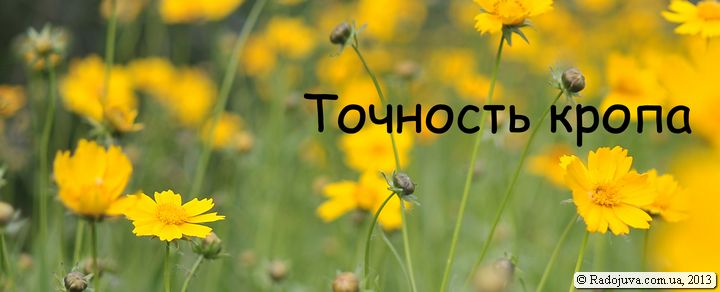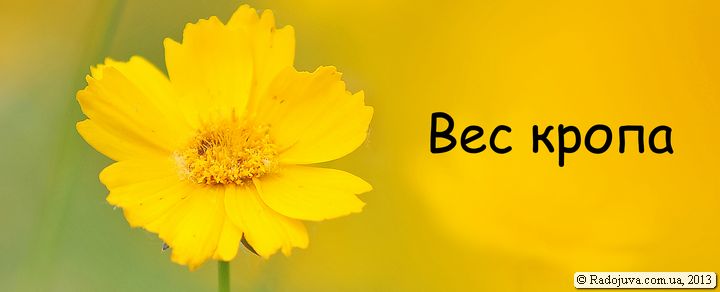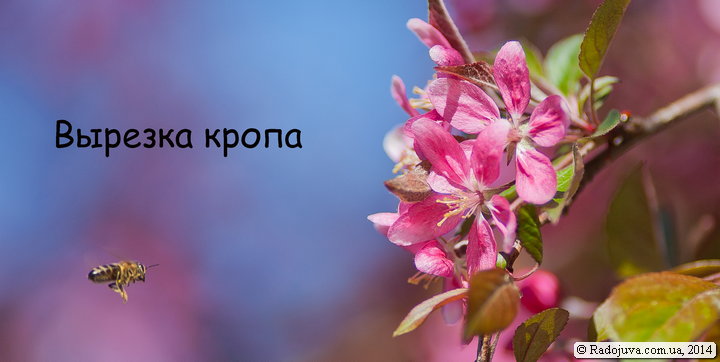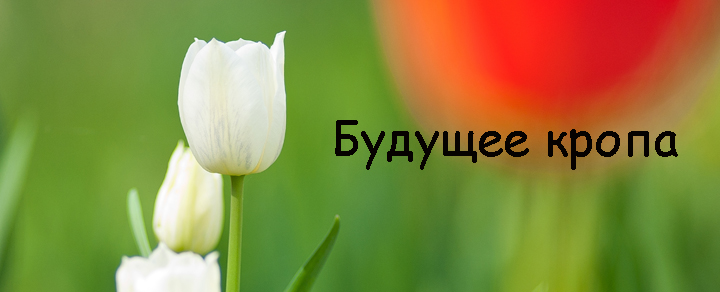This article is written in photographic slang and, moments, filled with my subjective opinions. This article describes the nuances of using cropped cameras and lenses, which few people pay due attention to.

Crop identification
'Crop', 'Crop', 'cropped camera', 'cropped camera', 'cropped sensor', 'cropped sensor' are synonyms for a camera with a reduced light-sensitive element (matrix, film). These concepts are strongly intertwined with the concept crop factor and basic information about crop can be found in the section ' Crop factor '.
Full frame Full Frame, FF, FF, Full sensor size are synonyms for cameras that have an original, not reduced photosensitive element. Nowadays, many amateur photographers believe that FF cameras are a panacea and the peak of the evolutionary development of modern digital cameras. Due to the fact that the price of amateur cropped cameras is several times lower than for full-frame cameras, a lot of amateur photographers use cropped cameras and dream of switching to full frame. Matrix size full-frame cameras is equal to the size of standard 35mm film (film type 135). But full frame is not the limit.
There are medium and large format cameras where the sizes of the photosensitive element are several times larger than the sizes of the photosensitive elements in full-frame cameras. Oddly enough it sounds, but modern full-frame digital cameras are narrow format... It turns out to be a kind of deception - on the one hand, a full frame is something beyond, on the other hand, a full frame is just a narrow format.
Photographers who have been shooting medium or large format all their lives most often look down on today's prohibitively expensive 'Full Frame Cameras' Nikon D4s, Canon 1DX and the like. I am writing this to the fact that there should be a clear understanding that full-frame cameras are just one of the steps in the evolution of camera engineering.

Crop Excellence
Since I use the Nikon system most of all, I will give examples based on Nikon's photographic equipment.
Basically, everyone knows that with the help of a FF camera it is easier to control the depth of field. With a full-frame camera, it is easier to achieve a thin depth of field, blurring the background and background.
But there is a second side to the coin, in which crop surpasses full frame. To get the same angle of view from a full frame lens Nikon AF-S Nikkor 24-70mm 1: 2.8G ED N used on a full-frame camera, on the crop you need to use an analogue - Nikon AF-S Nikkor 17-55mm 1: 2.8G ED IF SWM DX. We assume that 17mm crop and 24mm full frame give approximately same viewing angle and omit the difference 1.5mm EGF (Эequivalent Фsnack Рdistance, 17mm * 1,5-24mm = 1,5mm). But due to different real focal lengths, lenses have different depth of field and different hyperfocal distance... In practice, this has the effect that 17mm is easier to achieve a wide depth of field than 24mm full frame. For example, this is expressed by the fact that when I photograph a group of people in low light (for example, in a temple), the thin depth of field of the 24mm@F/2.8 lens is very strongly felt in the full frame and some of the people who 'fall out' of the field of focus are blurred. I do not need anyone to be blurred in the picture at all. At the same time, if you shoot the same scene with a 17mm@F/2.8 lens on a crop, the field of focus will be larger, this will allow you to capture all people in the field of focus, and when you print such a picture, all participants in the shooting will admire their sharp image. In this case, the lenses use the same aperture, and photographing occurs at the same shutter speed.
Often you can see a recalculation of aperture for cropped lenses. For example f / 2.8 for Nikon AF-S Nikkor 17-55mm 1: 2.8G ED IF SWM DX on cameras Nikon DX will have the equivalent of f / 4.2. You can look at the example of Nikon 14-24 2.8 on photozone.de. This does not mean that such a lens has a real darker aperture (smaller real aperture in terms of T-stops) when used on cropped cameras - this only means that the depth of field for such a lens will be F / 4.2 equivalent to full-frame cameras. Attention: this recount does not affect the exposure, it only affects the recalculation of the depth of field.
Thus, using Nikon AF-S Nikkor 17-55mm 1: 2.8G ED IF SWM DX at 17mm and F / 2.8 we get the equivalent of 25.5mm and F / 4.2. That is, to get the same large depth of field as with a cropped lens Nikon AF-S Nikkor 17-55mm 1: 2.8G ED IF SWM DX, using Nikon AF-S Nikkor 24-70mm 1: 2.8G ED AF-S N we will have to close the aperture to f / 4.2. But in the case of a full-frame lens, this will entail not only an increase in depth of field, but also a decrease exposure. The exposure will have to be compensated either by a longer shutter speed, or a higher ISO sensitivity or a higher flash output.
When you change the aperture by one stop, the depth of field changes in two times. F-stop numbers are F / 1.4, F / 2.0, F / 2.8, F / 4.0, F / 5.6, etc. The difference between f / 2.8 and f / 4.0 is one stop (two times). It turns out that when using a cropped lens, we gain more than twice the depth of field in magnification (F / 2.8 versus F / 4.2). To be precise, the depth of field is 2.25x for Nikon DX cameras. The increase in depth of field is linearly related to the size of the matrix. In fact, Nikon FX and Nikon DX sensors differ in their area by 2.25 times. The number 2.25 is very simple, you just need crop factor (Kf = 1.5) squared: 1.5 * 1.5 = 2.25.
This trick is used in many soap dishes for macro photography. The tiny sensors of digital soap cameras can produce huge DOF with small aperture numbers, which is very important for macro photography. So, to get similar pictures with a simple soap dish and Nikon D3s + Nikon AF Micro Nikkor 105mm 1: 2.8D on a soap dish it will be possible to calmly remove on F / 5.6 from hands with a short shutter speed, and on a large full-frame lens, you will have to close the aperture very strongly to get the same DOF.
Personal experience:
I described the difference in depth of field in detail only because I often shoot various kinds of wide-angle lenses on an open aperture baptism, weddings, etc. I usually use a 28mm lens. On a full frame at 28mm f / 3.5, it is already very noticeable that people 'fall out' from the depth of field. When printing in a format of 20 X 30 and more, it is already quite noticeable that some people are in focus, and some are 'floated'. Sometimes clients complain to me that part of the picture is not sharp. Using a crop camera and a lens with a similar EGF, you can increase the depth of field by a factor of 2.25 while maintaining aperture ratio and simplify this kind of shooting. I understand that you can close the aperture and get a wide depth of field, but in some cases you can’t shoot at F / 11.0, since there is very, very little light for the scene, and using a flash is highly undesirable.
Conclusion:
Equivalent focal lengths when using cropped lenses allow you to get a large depth of field, more objects in the focus area, more satisfied customers. At the same time, we need the same aperture the lens.

Ultimatu crop
After the previous point, the crop has risen to its feet and can now compete with a full frame. But there is one very serious problem when using cropped cameras. And this problem is the lack of lenses. In general, this concerns the absence good professional fast lenses with a comfortable EGF. Professional photographers, such as wedding planners, studio photographers, and storytellers most often use a specific set of lenses with a certain focal length. Usually this is a range of 14-200mm.
But for cropped cameras there are simply no lenses for comfortable shooting. For example, for Nikon DX cameras there is nothing to replace Nikon 14-24 F / 2.8, Nikon 17-35 F / 2.8, Nikon 70-200 F / 2.8, Nikon 80-200 F / 2.8, Nikon 85mm F / 1.4. There is only a replacement for the Nikon 24-70 F / 2.8 in the form of the Nikon 17-55 F / 2.8 DX (and then, there is a Nikon 24-70 F / 2.8 VR, which, again, has no replacement).
Lenses have historically undergone a number of adjustments to suit the needs of photographers when working on narrow 35mm film. We have developed our own optimal standards. For example, reporting in 'close combat' is easier than ever to shoot with the Nikon 17-35 F / 2.8, and for portraits, weddings, use the Nikon 70-200 F / 2.8. These lenses complement each other to provide the photographer's desired coverage of the focal length range, are very easy to use and are a kind of standard. These lenses have undergone a number of modifications, have been hardened by time, and their focal lengths were chosen for a reason.
As a result, for the Nikon DX crop, there is neither a wide aperture-panorama (14-24 F / 2.8), nor a reportage-wide (Nikon 17-35 F / 2.8), nor a portrait-TV (Nikon 70-200 F / 2.8), no fix portraiture (Nikon 85mm F1.4).
In general, for 'professional photography' on a crop, only the Nikon 17-55mm F / 2.8 can be used as a versatile replacement for the full-frame Nikon 24-70mm F / 2.8.
When using lenses from full-frame cameras, the EGF and full-frame lenses largely lose their functionality on crop. To reinforce my words, I will give an example from personal practice. Using a Nikon 70-200 F/2.8 lens on a full-frame camera, I can easily shoot wedding walks and small groups of people at 70mm, all I have to do is step back a little. But when using the same lens on a crop, I have to run back and forth with 70-200mm to shoot witnesses, young people and a few more people. As a result, the 70-200 does not fulfill its function as a normal 70mm lens. For serious photography, crop is a road to nowhere due to the lack of a set of lenses the photographer needs.
There is one more thing - third-party manufacturers have realized the nuance described above and released equivalents. For Nikon 14-24 F / 2.8 there is Tokina 11-16 F / 2.8, for Nikon 70-200 F / 2.8 there is Tokina AF 50-135mm F / 2.8. Nikon 17-35 F / 2.8 replacements were never invented. On the one hand, I often recommend third-party lenses, but I only do this for hobbyists. On the other hand, there is one unwritten rule for professionals to use only 'native' lenses on their cameras. Let me give you an example, so I came to a wedding with 'Tamron', 'Sigma', 'Tokina'. They ask me, what is this lens? I answer - 'Tamron', 'Sigma', 'Tokina'. In response, I only hear “There ... What? ... Sigma? Bokina? " And all my professionalism and trust in me is multiplied by zero. It is difficult to prove to the client that important how to take pictures, and not using any technique. Give everyone only Nikon, Canon, Sony.
Of course, it should be understood that the concepts of 'professional photographer' and 'professional photographic equipment' have very vague boundaries.
We can also mention Canon cameras with APS-H sensor - Canon EOS-1D, 1D MarkII, 1D Mark II N, 1D Mark III, 1D Mark IV, which have crop factor 1.3 and for which neither the native manufacturer nor third-party ones produce lenses taking crop into account. Only full-frame native lenses are suitable for such cameras.
Conclusions:
For full-frame cameras, there are lens solutions with a convenient set of focal lengths. For cropped cameras, there are practically no such lenses.

Crop evolution
In the previous paragraph, I tried to defeat the crop. At this point, I will try to finish it off.
Not only professional lenses have evolved, but also a number of simple 'dark' zooms. Usually, for comfortable, simple photography, the 28mm-XXXmm range is used. For example, 28-50mm, 28-70mm, 28-85mm, 28-100mm, 28-105mm, 28-200mm, 28-300mm. Such lenses are called universal, with their help you can practically shoot anything. Most of their versatility lies in their ability to use the wide 28mm field of view on a full frame camera. The equivalent of 28mm on crop is 18mm, for example 18-55m, 18-70mm, 18-105mm, 18-135mm, 18-200mm, 18-300mm.
For example, Nikon has over 10 class 28-XXX universal autofocus lenses and their modifications. All these lenses are practically unprofitable when used on cropped Nikon DX cameras, as they completely lose their versatility due to the fact that 28mm gives EGF at 42mm (almost fifty dollars). Now the good old lenses, for example, the Nikon 28-105mm F / 3.5-4.5 Macro with outrageous image quality and super fast focusing, are sold for $ 150, since no one needs them.
This is true not only of universal lenses, but of almost all full-frame lenses that have been designed for full-frame cameras. Black magic happens on crop, constantly full-frame lenses with specific goals and objectives'turn into something'. For example, a fifty-kopeck piece in a short-portrait, any shirik into a standard lens, over a shirik into a wide one. The only thing unchanged is the telephoto. Televik and televik on the crop.
The main advantage of crop marketing experts highlight 'free' increase in equivalent focal length. In fact, such an increase is needed only in very rare tasks. For example, I very rarely need a lens longer than 200mm at full frame. Few photographers can really use this advantage for shooting distant subjects. For an ordinary amateur photographer, such an increase EGF often not needed. Many remain deceived by what is usually said about the increase EGF for telephoto lenses. Everything is extremely simple there - the longer the focal length, the better. But due to the fact that the EGF increases not only for telephoto lenses, but for all lenses, from this wide angles suffer greatly. That is, the wide angle of a wide-angle full-frame lens simply disappears when using such a lens on a cropped camera. In general, it is better to shoot wider than narrower - the image can then be cropped, but not vice versa. Because I really like the expression: 'crop eats frame'.
Conclusion:
When using cropped cameras lost the ability to use a huge number of old full-frame lenses with excellent optical and mechanical performance. Often such lenses cost a penny, and their image quality is at a high level.

Crop accuracy
Another important point is accuracy of the focusing system when used on crop and on a full frame of FX lenses. It is connected with hyperfocal distance and a feature of the focusing system of each lens separately.
To shoot the same subject with the same full-frame lens in crop and full frame with the same crop, you need get closer or further to the subject. The difference in shooting distance between the Nikon DX camera and Nikon FX will be 1.5 times. For example, if you need to shoot something with a cropped camera and a full-frame lens from a distance of 6 meters, you will need to shoot something with the same lens and a full-frame camera with the same crop from a distance of 4 meters.
The focusing system is often easier to sharpen the lens at medium focusing distances. This can be related to the step of the focusing ring. When focusing in the infinity region, the focus ring pitch is very small, which may cause more problems with focus accuracy in this range. When using an FX lens on a crop, focusing is shifted toward infinity, which generally degrades the accuracy and smoothness of focusing. This is a very subtle nuance that can not always be traced. It takes a lot of practice to feel the difference.
And also an important point - the shorter the focusing distance, the visually the subject appears sharper (although the depth of field decreases).

Crop weight
It is often said that cropped cameras weigh less than full frame cameras. This is not always true. For example, full frame cameras Nikon D700, D800, Nikon D800E, Nikon D600 weigh less than the cropped Nikon D1, Nikon D1h, Nikon D1x, Nikon D2x, Nikon D2xs, Nikon D2h, Nikon D2hs. Also full frame Nikon D600 weighs about the same as Nikon's cropped ruler D500, D300, D300s, D200, D100. In the general case, the weight of the camera is determined not by the size of the sensor, but by the belonging of the camera to a certain level, for example, professional or amateur. The weight of the camera is very dependent on the materials of which the housing is made. Typically, professional cameras have an all-metal body, unlike amateur cameras that use plastic. So it turns out that professional flagship (with a combo body) cropped cameras of the Nikon D1, D2 series weigh more than an amateur full-frame Nikon D600 or professional Nikon D810, D800, D800E. The weight of the camera can be both a plus and a minus, like everything else in matters of crop.

Crop speed
The implicit advantage of the reduced sensor on cropped cameras is the ability to quickly read the signal from the cells of the matrix and lower power consumption. In fact, this greatly affects the video. So, the first Nikon camera that could shoot video was not Nikon D3s, Nikon D90. Now Nikon D7100, D7200, D5200, D5300, D5500 can shoot Full HD at 60 frames per second, and more expensive cameras Nikon D600, D610, D800,D800E, D4 can squeeze a maximum of only 30 frames per second in Full HD mode. This also affects the photo shooting speed. So cameras with interchangeable lenses Nikon 1 J1, Nikon 1 S1, Nikon 1 V2, Nikon 1 V1, Nikon 1 J2, Nikn 1 J3 and Nikon 1 AW1 can take pictures at a speed of 60 (sixty) photos in one second. It turns out that crumbs Nikon 1 s crop factor 2.7X shoots 5 times faster than Nikon D4s or Canon 1DX. Such speed is possible due to fast reading and signal processing from a 'small' matrix.
Unlike Canon cameras, Nikon full-frame CCMs can operate in DX image mode. This means that any full-frame camera can only use the central part of its sensor, which is completely identical in size to the classic Nikon DX crop. To do this, simply select the DX image area in the camera menu. Thus, using any Nikon FX cameras, you can simultaneously have at hand an analogue of a cropped camera. For example, in Nikon DX mode, the camera Nikon D800 takes 16MP pictures, in size and quality almost the same as when using cropped cameras Nikon D7000 or D5100. True, in Nikon DX mode it is inconvenient to sight through JVI. By the way, some Nikon DX cropped cameras can work in their specific optional cropped mode. These cameras include Nikon D2x и D2xs with an additional crop for high-speed shooting Kf = 2X and Nikon D7100 with the possibility of additional crop Kf = 1.3X.
Of course, crop cameras have been and always will be. But here in the professional segment, cropped cameras no longer have a place... For example, Nikon no longer releases TOP cropped 'combo monsters', the last of which was Nikon D2xsreleased way back in 2006. In 2007, Nikon's line of TOP professional cameras was replaced by a full-frame line, the first of which was Nikon D3. In the future, the entire range of such cameras includes exclusively full-frame models.
The same fate befell the line of cropped TOP cameras Canon with an APS-H sensor. Latest model, Canon 1D Mark IV, was released in 2009, replaced by a full-frame camera in 2012 Canon 1D X.
All the previous ones are just flowers :) (which are on screensavers). For me, as a photographer, full-frame cameras are valued more than cropped cameras due to lower noise at equivalent ISO values. Full-frame cameras have higher ISO values that allow you to take pictures of acceptable quality. If we take cropped and full-frame cameras of the same generation, then full-frame shots will always be more flexible in post-processing, they are much simpler 'draw out'and finalize (especially when shooting in RAW).
Let's take the latest full-frame model among Nikon cameras - D4s, and the latest advanced cropped - D7100, even according to synthetic tests, it is easy to see that the 'working' ISOs of Nikon D4s are 2-3 times higher than those of Nikon D7100 (link dxomark.com). I can say with confidence that no Nikon cropped camera has yet grown in terms of noise at high ISOs even to the very first full-frame Nikon D3. The same situation can be observed with Sony and Pentax cameras. And if you do not take into account Canon EOS-1DS then Canon has exactly the same situation :).
Comments on this post do not require registration. Anyone can leave a comment. Many different photographic equipment can be found on AliExpress.
Global output:
Crop is insidious. Now you know that:
- A full frame can be considered crop from medium format cameras;
- Crop has the advantage of greater depth of field with the same F number and the same viewing angle. This is important for shooting using wide-angle optics;
- For crop there is no line of professional lenses with convenient focal length. In my opinion, this is a very serious drawback of crop;
- Cropped cameras cannot be used properly with a huge number of good old full-frame lenses;
- When using full-frame lenses on crop, the smoothness and convenience of focusing changes;
- Cropped cameras are not always lighter than full frame cameras;
- Full-frame cameras have a significantly lower noise level at high ISO;
- Among professional cameras, there is less and less space for crop.
Extension here.
Material prepared Arkady Shapoval. Training/Consultations | Youtube | Facebook | Instagram | Twitter | Telegram





Simple and clear, as always. Thank you Arkady!
As usual, good thoughts and a useful article!
Thanks, Arkady.
Interesting and useful article. I expanded my knowledge. I'd like to add that with all the drawbacks of the crop, it still attracts with the price and other marketing tricks, and as before we put the good old Soviet lenses on the crop ...)
But for some reason I made a different conclusion for myself - it is better to buy even a used one. D700 and lens 28-105 than in a bundle new or used. A crop camera and a 17-55 2.8 lens .. for about the same price, but in the first case we will have a full frame and the possibility of choosing a whole range of inexpensive good full-frame lenses, and in the case of a crop the choice will be very limited.
Thank you Arkady for the fascinating material and fresh thoughts!
Crop faator is still an ambush))) As well as the revelation that a full frame is a narrow format.
But this is only for modern digital mirrors. For photographers, the old hardening that was filmed, plates, etc. (to which I do not belong) is in the order of things. Then the 35mm film (the current full-frame) was considered a purely amateur (narrow) format, the pros were shot at least on a medium format film, and in the studio on large format records. The last time I shot in a photo studio in '97, on a camera with furs and a photographer, practicing shutter speed, with magical passes removed the lens cap, waved it three times and put it back. That is, the shutter speed was three (!) Seconds, for the picture had to go in two days. And it was a PICTURE!
Well it is, nostalgia is in the order of the flood….
Arkady, thanks for the article! I constantly read your blog, I look forward to new articles and reviews.
Dear, is it not on the camera of the Obscura that you were photographed?
3 seconds - oga ... furs - oga ...
Yes, even me in shaggy 97 or even 98, they took a photo on the first passport. There was a wooden apparatus, a photographer under a curtain and waving a little porch.
But interestingly, an analogue of 60mm film is produced in digital? And how do they fight the little DOF?
uh huh .. google “mamiya”. only the prices are there ... the Yandex market just nervously smokes.
I looked. Hassel, Mamiya. It's interesting all the same about the depth of field. They probably can't shoot at 1.8 at all ...
They have no such holes. Usually it all starts with f / 3.5
You do not forget about crop factor 0.4
Here you have aperture 1.4
+100500 Arkady !!! With a crop, I feel that I was stabbed somewhere, but where? .... now it's clear, thanks, I'm saving up for a full frame.
A little off topic
Crop identification, Crop superiority, Crop ultimatum.
best comment!
Forgot about the evolution of crop.
here I can not post this image, IMHO, most fully describing the beginning of comments:
http://ic.pics.livejournal.com/lynx_tassi/8802956/142840/142840_600.jpg
In general, it is very informative, but monopisssual in terms of "throwing between fish and cheese."
I would generally replace my D90 with 3100 if that one had a top screen. )) Carrying is easier.
Everything can be.
Thank you, very informative !!
"The accuracy of the focusing system when used at crop and full frame"
That's for sure)) Kaleinarik on Crop strongly lathers and a lot of pictures with grease, and as soon as he gets up on the D700, all the pictures burst from sharpness at the seams)
Thanks for the review)
I’m shooting on film and there are no problems!
But somehow this question doesn’t bother me at all. The 17-50 f / 2.8 tamron is enough for me, in the future I will buy an 11-16 f / 2.8 tokin to get a normal wide angle and be calm about this. It’s more convenient for me, having a cheap nikon d80, than spending $ 1000-1500 for a full frame and then using cheap lenses because the money is over.
Yuri - Golden words! There is no point in comparing matrices of different sizes, everyone can choose the size of the matrix for themselves according to their needs, desires and the amount that they are ready to spend on a photo system for themselves! I also use a Tamron 17-50 on the D7000 and it is completely outdated for me. but I would also like to get a universal zoom for holidays. And here's the bad luck: I shoveled a bunch of reviews and tests, considered Nikon 18-200, Nikon 18-300, Tamron 18-270 и Sigma 18-250... Sigma 18-250 was the best according to many tests and reviews read. The Nikon 18-300 and Tamron 18-270 have poor reviews, the nikon 18-200, in principle, looked good in these reviews. Well, suddenly one of my friends orders Sigma 18-250 Macro and I decided to take a test from him before buying it myself! And what am I finding out? The lens is complete shit! Low-contrast picture, no stabilizer at all! Under certain conditions (I could not determine under what conditions), at different focal lengths, the stabilizer starts slowly in a circle, clockwise to twist the picture, and as a result, even at short shutter speeds and 18 mm, blur is obtained. But Tamron 18-270 and Nikon 18-300 just give out excellent quality and the work of the stabilizer, especially in Tamrona, is generally impressive ... So I would have got to Sigma, if not for the case ....
Nikon 24-120 / 4
Try Tamron 18-250 3.5-5.6 without any stubs - you can still find it. I like!
Tokina at 16 in full frame shoots perfectly and without a vignette, for 800 bucks.
Matrices do not change much, but glass is cheap and expensive.
In general, if you don’t find fault with art, if you just need to capture an event with maximum sharpness of all elements of the frame, then the smaller the matrix, the better. In some moments, when I can't get a frame on the crop, I envy the sharpness of the soap boxes. And sometimes such a shot simply cannot be taken - there is simply not enough light. You have to open the diaphragm, hence the depth of field, etc.
Thank you, Arkady! I just realized for myself that for my tasks my D90 + Tokina 11-16 is what I need. And then somehow thoughts about FF crept in ...
Crop is the result of the cheapening of matrices at the beginning of the digital age. it can be obtained by conventional cropping. therefore I recommend to everyone the full frame. By the way, the result of the photo depends not only on the lens, but also on the matrix of the device. Here I dug up the DXOmark rating and compared my two cameras and a potential replacement:
Lens / score for: D 70s> D90
> D800 (more is better).
Nikon AF-S Nikkor 85mm f / 1.4G / n / a> 22> 40
Nikon AF-S Nikkor 85mm f / 1.8G / n / a> 23> 40
Nikon AF-S Nikkor 24mm f / 1.4G ED / n / a> 19> 34
Nikon AF-S Nikkor 35mm f / 1.4G / n / a> 19> 33
Nikon AF-S VR Micro-Nikkor 105mm f / 2.8G IF-ED /
n / a> 17> 32
Nikon AF-S Nikkor 50mm f / 1.4G / n / a> 18> 32
Nikon AF-S Nikkor 50mm f / 1.8G / n / a> 17> 31
Nikon AF Nikkor 50mm f / 1.8D / n / a> 16> 29
Nikon AF-S Nikkor 70-200mm f / 2.8G ED VR II / 11>
17> 29
Nikon AF-S Nikkor 14-24mm f / 2.8G ED / 10> 15> 28
Nikon AF-S Nikkor 24-70mm f / 2.8G ED / n / a> 15>
28
Nikon AF Nikkor 20mm f / 2.8D / n / a> 14> 25
Nikon AF-S Nikkor 24-85mm f / 3.5-4.5G ED VR / 8>
12> 22
It’s clear that a full frame is better. But it is not cheap, and if a person takes off just like that, for himself, then paying 1000-1500 dollars for the device does not seem reasonable, at least in the coming year. A good crop like d90, d300 And above you can buy for 3000-4000 UAH.
the first chapter of an ideal book “how to choose a DSLR” should be called “how to make $ 5000 fast” ;-)
it will be hard for an ordinary amateur photographer to spend a round sum for a full frame with decent glasses. but if you have enough experience with crop shooting, then switch exclusively to FX. I do not think that a beginner enthusiast with a normal income can ruin a full-frame camera as a starter. if he is really eager to learn how to shoot - he will master it!
That's for sure) But for my five kopecks I will say this - if an amateur does not care what shots will turn out - at first you can train on anything, but in your mind you can have further growth - first to D4 / 1D X or to D600 / 700/800 (let these are different groups / classes) + a set of optics ... But with this during the initial training, you do not need to rush - and the entire blog of the esteemed Author just talks about this: collect interesting glass that will be useful to you later in a narrow format. And in the future, it is already a medium format - but there are laws / conditions / restrictions. In particular, the almost complete impossibility of reportage filming.
in this it is true, I have a cropped camera and Nikon F100 and F80 film, so at weddings more film is welcomed for it, they pay more for it, as a sightseeing photo ... and no need to invest, for progress you will not have time everywhere money and not small, but the film is and in africa the film has been tested for years. count the arithmetic at once everything will become clear ...
Something I did not fit with my D7000 at $ 1000-1500. Flash SB-910, two Yongnuo manual, plus a pair of lenses, a tripod, photo umbrellas, radio synchronizers, a bag. total about 100 thousand rubles.
Arkady, your quote: "Now the good old lenses, for example, Nikon 28-105mm F / 3.5-4.5 Macro with exorbitant image quality and super fast focusing are sold for $ 150, as nobody needs them."
Can you tell me where you can buy such a lens for that kind of money? Naturally in fair condition ...
ebay com. Last week I bought the aforementioned Nikon with Hoya hood and filter. For everything - $ 122. Delivery 30 more.
there was Nikon D70 with this lens for $ 200 with delivery.
It seems to me that if the article is NOT called "Disadvantages of Crop", then more should be said about its advantages! As an amateur, I am fond of shooting macro and living creatures (tele). Taking into account the EGF, there is nothing like that for comparable money on FF and will not be.
Kenon 240 for $ 170 is perfect for macro.
Thank you, Arkady, for your ability to correctly and intelligibly sort out the necessary information “on the shelves”. I want to emphasize the phrase: "the concepts of 'professional photographer' and 'professional photographic equipment' have very vague boundaries."
Thank you for the article, but is it correct and whether it is necessary to look for equivalent focal lengths and, all the more, an equivalent aperture when installing a full-frame lens on a cropped carcass. After all, optically, as we know, only the angle of view of a particular objective depends on the crop factor of the matrix, that is, neither the focal nor the more aperture changes. Personally, my opinion is that you just need to get used to the behavior of the lenses on the crop, for example, at first I could not understand why 50 1.8D does not exactly focus on the crop during growth portraits, but the focus on such growths was on the very edge of the focus ring)
<> Obvious mistake. Should be (17mm * 1,5-24mm = 1,5mm). The rest is a brilliant review. I read like a song.
Yes thank you. Updated.
Thank you for the article. I am an amateur, I love to photograph and enjoy the result. My arsenal is Nikon D7000; Tokina 14 x 26; Tamron 17 x 50; Nikkor 70 x 210. Photography is an occupation for the soul, as for me. From one vacation trip I bring from 1000 to 2500 photos. The article makes you think, but as in any business there are pros and cons, the main thing is that Arkady shows how to use them so that there is no disappointment.
Thanks so much for the article! Details are not tired at all :)
Your articles are of great help in the difficult choice of photographic equipment, especially if "mirrors" are chosen for the first time. The choice is becoming more and more precise. It looks like it will be a Nikon d7000 with a kit 18-105VR.
Arguing on the topic of depth of field vs aperture vs sensor size, one important point has been missed.
even if you are forced to squeeze a hole in ff to increase the depth of field and this leads to an increase in ISO, you must understand that in terms of noise, FF is usually proportionally better than crop, i.e. in the end, you have nothing to lose.
I mean, that you can always close a hole and get a bigger DOF, but the opposite, alas, does not work.
They also forgot about the plus of the crop: this is its weight.
In this article, I did not describe the advantages of a crop. This article deals with the subtleties that many are silent / do not know. General information about the pros and cons here - https://radojuva.com.ua/2011/05/size-of-matrica/
You can discuss as much as you like on the subject of crop and ff, but only theorists will tell you one thing - any zoom on crop will shoot further than on ff. 50 on ff give 75 on crop. The savings are in excess focal, in money, according to parity.
d7000 and d5100 in terms of iso not inferior to the same marketing foster d600.
I'm a professional in the photo and I know what's what, otherwise they will buy ff and everyone thinks - there will be masterpieces. Crop will do a lot of ff now, because the characteristics are very cool.
But all the lenses go to crop, but ff does not eat cropped ones. so this ff is resting.
Yakbi, then you do not rozcharuvati, FF ob'yktivi on crop does not have a greater zoom, but deprives the іnshiy kut to look around, through the viglyadaє nіbi zbіlshu.
Spring salad from the greenhouse, can I see your work somewhere?
hmm) Dear author, in the D700, if you suddenly do not know, there is a built-in tool such as defining lenses))) crop as much as you want, using a very low-noise and high-aperture matrix ... test data to help you, dear user - there you can see soundly and in detail where the D600 noises start - approximately where you cannot take pictures on 5100)))))